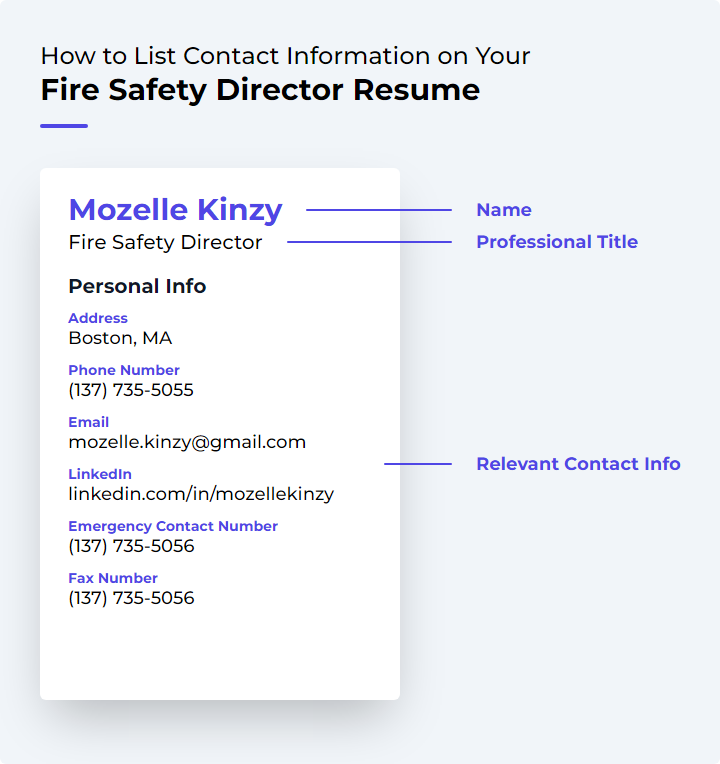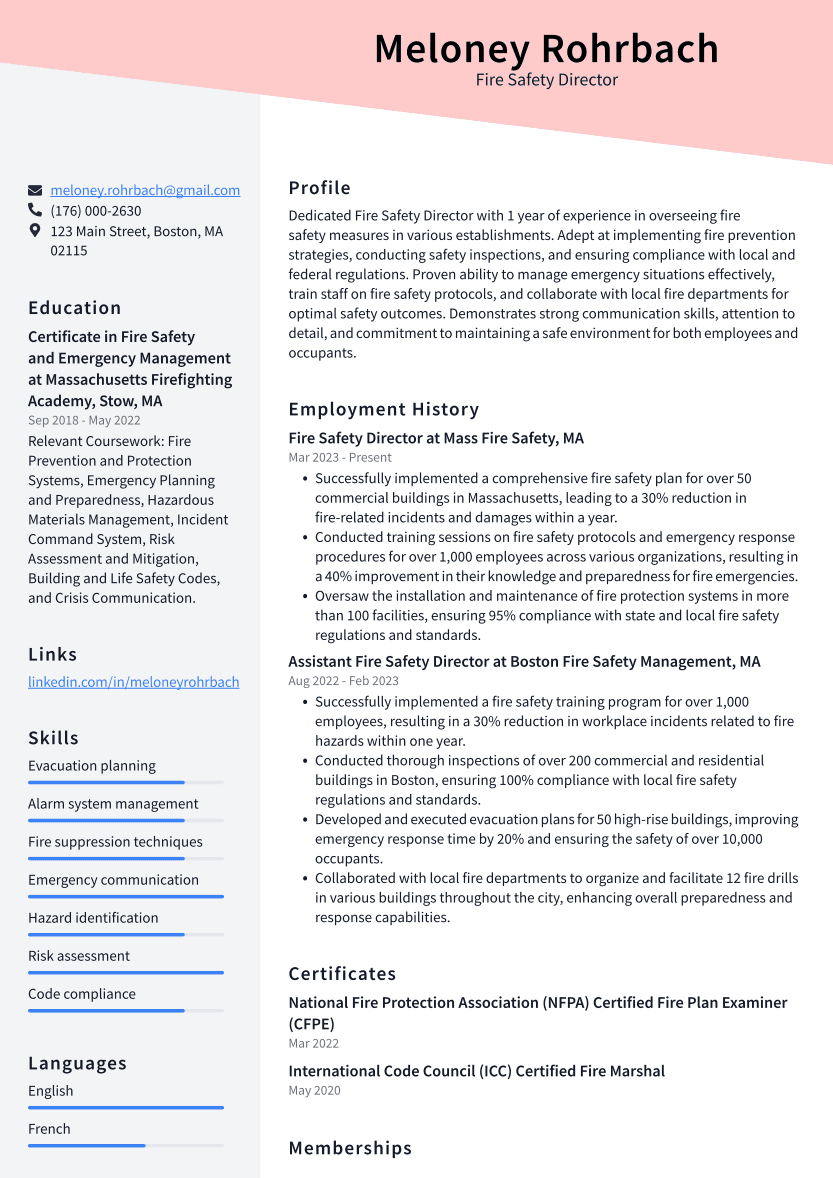Fire Safety Director Resume Examples
Writing a great fire safety director resume is important because it is one of the first things a potential employer will see when they are considering you for a position. It is your opportunity to make a good first impression and sell yourself as the best candidate for the job.
Create your resume
Select from 7 professional resume templates
If you're looking for inspiration when it comes to drafting your own fire safety director resume, look no further than the samples below. These resumes will help you highlight your experience and qualifications in the most effective way possible, giving you the best chance of landing the fire safety director job you're after.
Essential Components of a Fire Safety Director's Resume
A resume for a Fire Safety Director is a critical document that showcases the candidate's expertise, experience, and qualifications in fire safety management. A well-crafted resume should highlight specialized training, certifications, practical experience, leadership capabilities, and a thorough understanding of fire safety regulations. In the following sections, we will delve into the various elements that constitute an effective resume for this role, offering insights and tips to enhance each section.
1. Contact Information
At the top of your resume, ensure the Contact Information section is prominent and includes your full name, address, phone number, and a professional email address.

Accuracy in your contact details is crucial for potential employers to reach out for interviews or further discussions. Regularly check your contact methods to avoid missing opportunities. Include a reliable phone number with voicemail and a professional email address, ideally composed of your first and last name for easy identification.
Consider adding links to professional online profiles, such as LinkedIn, or a personal website that showcases your fire safety management expertise. Ensure these profiles are up-to-date and professional in appearance.
- Avoid including personal details such as date of birth, marital status, or social security number, as they are not pertinent to the job application and could lead to bias.
The goal is to make it effortless for hiring managers to contact you, so clarity and precision are paramount in this section.
2. Objective Statement
The Objective Statement serves as your introductory pitch to prospective employers. In a concise one or two sentences, articulate your career goals and explain why you are an ideal candidate for a Fire Safety Director position.
Highlight your relevant skills, experiences, qualifications, and personal attributes that align with the job's requirements. Tailor this statement for each application to demonstrate your understanding of the role and how you can contribute to the company's fire safety objectives.
An example of an objective statement could be: "With over a decade of experience in managing fire safety protocols, I am seeking a Fire Safety Director role to apply my comprehensive knowledge of fire prevention, emergency response planning, and staff training to ensure optimal safety."
This section is your chance to capture the employer's attention and make a compelling case for your candidacy. Use industry-specific terminology to enhance your resume's chances of passing through Applicant Tracking Systems (ATS).
- Clearly express your career aspirations.
- Emphasize qualifications and experiences pertinent to fire safety management.
- Show how your attributes align with the job's specific requirements.
An effective objective statement should succinctly convey your suitability for the Fire Safety Director role.
Related: Top Fire Safety Director Resume Objective Examples
3. Relevant Work Experience
Your work experience section should spotlight roles directly related to fire safety and emergency management. List your previous positions in reverse chronological order, including job titles, company names, and dates of employment. Provide a brief description of your responsibilities and achievements in each role.
Detail your experience with emergency response, fire safety procedures, staff training, and regular safety inspections. Mention any specialized equipment or software you've used, such as fire alarm systems or risk assessment tools.
Highlight your accomplishments, such as successful fire containment without casualties or property damage. Also, include transferable skills like leadership, communication, and problem-solving that are relevant to the Fire Safety Director role.
4. Certifications and Licenses
Certifications and licenses are crucial in validating your expertise in fire safety. They may be mandatory for certain positions and enhance your professional credibility.
- Fire Safety Director Certification: A foundational certification obtained through comprehensive training in fire safety, including prevention, emergency evacuation, and building codes.
- Certified Fire Protection Specialist (CFPS): Offered by the NFPA, this certification demonstrates proficiency in fire protection, safety standards, and risk analysis.
- Certified Fire Inspector (CFI): This certification indicates expertise in conducting thorough inspections to identify fire hazards and ensure code compliance.
- State Licensing: Some states require specific licenses for Fire Safety Directors, which may involve passing exams or additional training.
- First Aid/CPR Certification: While not always required, these certifications show preparedness for emergency response.
- Hazardous Materials (HazMat) Certification: Essential for those working with hazardous materials, indicating knowledge of safe handling practices.
- Incident Command System (ICS) Certification: Beneficial for those who may need to lead emergency response teams.
Include these credentials on your resume to demonstrate your commitment to maintaining expertise in fire safety. Ensure you list any relevant expiration or renewal dates.
Related: Fire Safety Director Certifications
5. Skills and Competencies
The "Skills and Competencies" section is essential for showcasing your fire safety expertise. Highlight both hard skills (technical knowledge) and soft skills (interpersonal abilities).
- Technical Knowledge: Deep understanding of fire safety regulations, emergency plans, and fire prevention systems.
- Training Skills: Ability to conduct fire safety training, including drills and equipment usage.
- Emergency Response: Quick and effective action in emergencies, including evacuation management and first aid.
- Leadership Skills: Team management, decision-making under pressure, and clear communication.
- Attention to Detail: Meticulous inspection of fire safety equipment and identification of potential risks.
- Problem-solving Skills: Proactive identification and resolution of fire safety issues.
- Physical Fitness: Ability to perform physical tasks during emergencies.
- Computer Literacy: Proficiency in using software for report writing, record-keeping, and fire simulations.
- Communication Skills: Effective information dissemination during emergencies and training.
- Compliance Management: Ensuring adherence to fire safety regulations within the organization.
Adjust this section to reflect the specific requirements of the employer or the type of facility you will be working in.
Related: Fire Safety Director Skills: Definition and Examples
6. Education and Training
The "Education and Training" section should highlight your academic background, certifications, and specialized training relevant to the Fire Safety Director role.
- School Education: List your highest level of education, such as a high school diploma or a degree in a related field, along with the institution and graduation date.
- Certificates: Mention any certifications from recognized organizations like the NFPA or local fire departments.
- Special Training: Include training programs related to fire safety management, such as fire prevention and emergency evacuation planning.
- Skill Building Programs: Workshops or seminars focused on leadership, crisis management, and communication can be listed here.
- Ongoing Learning: Participation in professional development courses demonstrates your commitment to staying current in the field.
Present this information succinctly, starting with the most recent education or training. Include any identification numbers associated with your certifications.
7. References
References are crucial for a Fire Safety Director's resume, providing potential employers with the opportunity to verify your competencies and character through those who have previously worked with you.
Choose references who can attest to your ability to handle high-pressure situations, lead teams effectively, and adhere to safety protocols. Include their full name, job title, employer, contact information, and your professional relationship.
- Always obtain permission before listing someone as a reference. This prepares them for potential contact from employers and allows you to discuss specific achievements they can highlight.
- The quality of your references can significantly impact an employer's perception of you, so select individuals who can provide positive, detailed feedback.
- While it's common to state "References available upon request," having them prepared for an interview shows proactiveness, a key trait for a Fire Safety Director.
